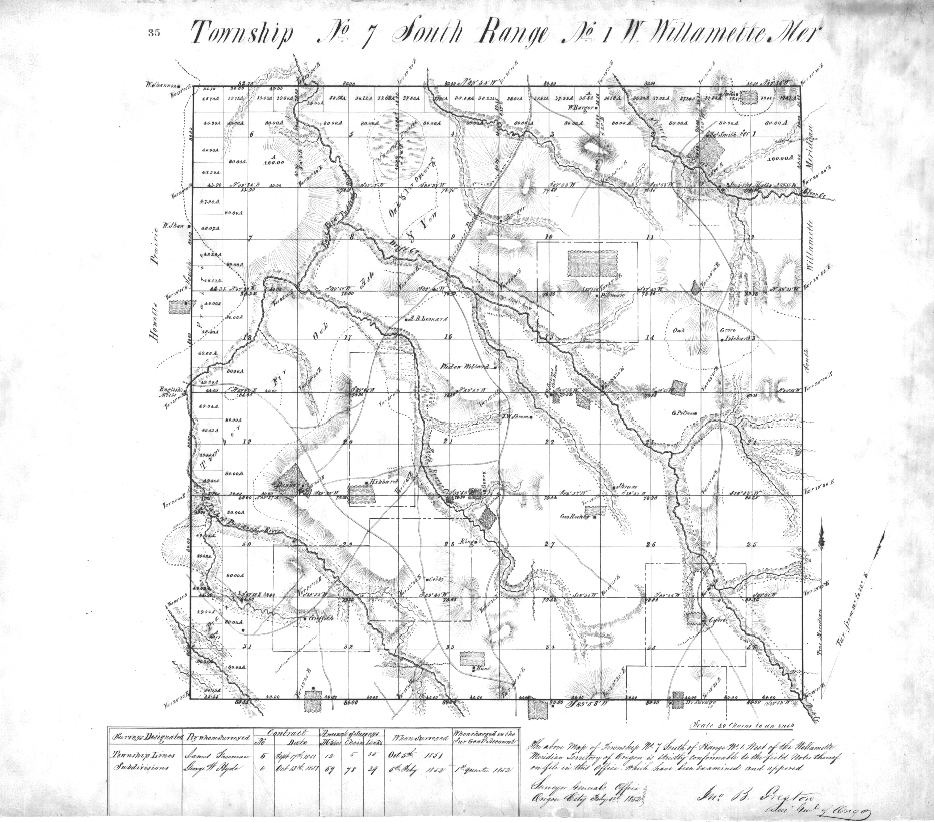The Daniel and Melinda Waldo House, constructed in 1854 in the Waldo Hills, east of Salem near present-day Macleay, was the home of the Waldo family who came to Oregon from Missouri with the Great Migration of 1843. They settled their 640-acre Donation Land Claim that year and built a temporary log cabin, which was followed in 1844 by a larger, hewn-log house. Not until ten years later, after more fully developing their farm, was the existing house constructed.
The Waldo House, one of the oldest remaining houses in Marion County, is representative of some of the finer pioneer houses constructed in the Willamette Valley during the 1850s and 1860s. Although the building is missing the original front porch, it displays the symmetrical and restrained characteristics of the Federal Revival architectural style, with some Classical Revival influences. The original building was embellished, probably by about 1860, with a heavier, articulated eave and the addition of a second-floor porch with full pediment, much of which has been removed. According to the July 23, 1899, Portland Oregonian, the house was “completed at a cost of over $5000.” Reportedly, the cost was more than expected because of “the necessity of shipping the doors and windows, which are hand-made, around the Horn, the business being attended to by Joe Lane.” The lumber for the house “was hauled from Newsom’s mill, on Howell prairie...by ox teams.”
As originally designed, the timber-framed Waldo House had two front rooms, each with a fireplace, probably used as a parlor and dining room. A one-story rear extension (which was reportedly demolished in the 1970s) encompassed a kitchen and probably other working areas of the house—perhaps a woodshed, fruit or cool room, or pump facilities. The large, two-story structure to the rear of the house appears to date to the later years of the nineteenth century, and was apparently used for water storage; it has since been converted to living space.
In 1843, the Waldos successfully ushered sixty-eight head of American cattle to the territory. By 1850, 250 of the 640 acres was improved or cultivated, with the remainder evidently used for open grazing land. The Waldo men were also actively involved in early Oregon political and social history, with sons William and John rising to prominence as lawyers, legislators, and early environmental advocates.
The Waldo name is associated with early Black pioneer history. Daniel Waldo owned slaves before 1830; after that date he held no people in bondage. He was reportedly friendly with and supportive of local African Americans at a time when Oregon’s exclusion laws banned Blacks from residing in the territory and provided refuge for a number of individuals in need of shelter.
Members of the Waldo family occupied the house until the early twentieth century, when it became a rental and was later sold out of the family. The house was occupied until the mid 1990s, when it was damaged by fire. It has remained unrepaired and vacant since that time.
-
![]()
Waldo House.
Courtesy Oregon Hist. Soc. Research Lib., 46770, photo file 1087
-
![]()
Waldo House, 2013.
Courtesy Liz Carter, Restore Oregon
-
![]()
Daniel Waldo, Cartes-de-Visite photograph.
Oregon Historical Society Research Library, Digital Collections, Cartes-de-visite collection; Box 8, A-193
-
![Remnant of a wagon brought across the plains to Oregon by the donor's father, Daniel Waldo, in 1843. Made in Montana. Donated by John B. Waldo in 1900.]()
Wagon wheel hub, 1843..
Remnant of a wagon brought across the plains to Oregon by the donor's father, Daniel Waldo, in 1843. Made in Montana. Donated by John B. Waldo in 1900. Oregon Historical Society Museum Collection, 40.
Related Entries
-
![Black Exclusion Laws in Oregon]()
Black Exclusion Laws in Oregon
Oregon's racial makeup has been shaped by three Black exclusion laws th…
-
![John B. Waldo (1844-1907)]()
John B. Waldo (1844-1907)
John Breckenridge Waldo was the first Oregon Supreme Court chief justic…
-
![Waldo Hills]()
Waldo Hills
The Waldo Hills are situated on the east side of the mid Willamette Val…
-
![Waldo Lake]()
Waldo Lake
Located astride the backbone of the Cascade Mountains in the Willamette…
Map This on the Oregon History WayFinder
The Oregon History Wayfinder is an interactive map that identifies significant places, people, and events in Oregon history.
Further Reading
"Old Waldo Homestead in the Hills." Oregonian, July 23, 1899.
Johnson, Brian Waldo. "America Waldo Bogle and the Question of her Ancestry." The Oregon Territory and Its Pioneers. http://www.oregonpioneers.com/AmericaWaldoBogle.htm








